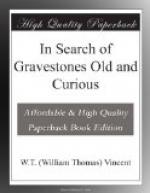Fig. 82.—At cheshunt.
“To Mary Lee, died July, 1779, aged 49 years.”
In the illustration I selected at Cheshunt the left half of the picture appears to denote Life and the right half Death. In the former are the vigorous tree, the towers and fortresses, the plans and working implements of an active existence. In the latter the withered tree, with the usual emblems of death and eternity, emphasizes the state beyond the grave, and in the centre are mushrooms, probably to point the lesson of the new life out of decay.
Hatfield is another instance of preservation without change, none of the old stones having, so far as one can judge, been allowed to sink into the earth, nor, as is too often the case, to heel over, to be then broken up, carted away, or put to pave the church and churchyard. There is quite a collection of primitive and diminutive headstones, carefully ranged against the south wall of Hatfield Church, dating from 1687 to 1700; and the specimens of carving in the older parts of the churchyard are of great number and many designs. The one which appears in the sketch (Fig. 83) is curious by reason of the peculiar decoration which fringes the upper edge of the stone. It is somewhat worn away, and I cannot discover whether the ornament was intended for some sort of aigrette, or, which it closely resembles at the present time, a string of skulls.
FIG. 83.—AT HATFIELD.
“To the wife of John Malsty (?), died 1713.”
There appears here, as elsewhere, to have been a tendency at times to repeat unduly such familiar figures as the open book, but, as a whole, Hatfield is a good example of a country churchyard. There are many other old burial-grounds thoughtfully kept in as good, or even better, order than the two here quoted; but it is for the respect shewn to the ancient memorials of the village fathers, rather than the churchyards themselves, that I have ventured to select them as patterns for imitation. There is another curious border on a stone in the secluded but well-kept country churchyard of Northolt, Middlesex.
[Illustration: Fig. 84 Northolt.]
Fig. 84.—At Northolt.
“To William Cob, died 25th
September 1709,
aged 68 years.”
Twickenham, in the same county, but now grown into a town, has modified its churchyard to its needs, without much change, and I give it a sketch in recognition of a sufficient and not excessive well-doing. Neither of these two examples call for other remark, being of simple interpretation.




